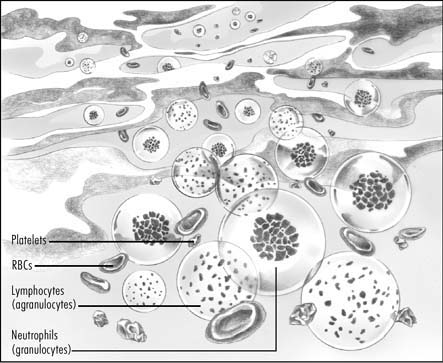Leukemia, acute
Acute leukemia is a malignant proliferation of white blood cell (WBC) precursors (blasts) in bone marrow or lymph tissue and their accumulation in peripheral blood, bone marrow, and body tissues.
The most common forms are acute lymphoblastic (lymphocytic) leukemia (ALL), characterized by the abnormal growth of lymphocyte precursors (lymphoblasts); acute myeloblastic (myelogenous) leukemia (AML), in which myeloid precursors (myeloblasts) rapidly accumulate; and acute monoblastic (monocytic) leukemia, or Schilling’s type, characterized by a marked increase in monocyte precursors (monoblasts). Other variants include acute myelomonocytic leukemia and acute erythroleukemia.
Untreated, acute leukemia is invariably fatal, usually because of complications that result from leukemic cell infiltration of bone marrow or vital organs. With treatment, the prognosis varies.
With ALL, treatment induces remissions in 90% of children (average survival time is 5 years) and in 65% of adults (average survival time is 1 to 2 years). Children ages 2 to 8 have the best survival rate with intensive therapy.
With AML, the average survival time is only 1 year after diagnosis, even with aggressive treatment. With acute monoblastic leukemia, treatment induces remissions lasting 2 to 10 months in 50% of children; adults survive only about 1 year after diagnosis, even with treatment.
Causes
Research on predisposing factors is inconclusive, but points to some combination of viruses (viral remnants have been found in leukemic cells), genetic and immunologic factors, and exposure to radiation and certain chemicals.
Pathogenesis isn’t clearly understood, but immature, nonfunctioning WBCs appear to accumulate first in the tissue where they originate (lymphocytes in lymph tissue, granulocytes in bone marrow). These immature WBCs then spill into the bloodstream and from there infiltrate other tissues, eventually causing organ malfunction because of encroachment or hemorrhage. (See What happens in leukemia.)
Incidence
Acute leukemia is more common in males than in females, in whites (especially people of Jewish descent), in children between ages 2 and 5 (80% of
all leukemias in this age-group are ALL), and in people who live in urban and industrialized areas. Acute leukemia ranks 20th in causes of cancer-related deaths among people of all age-groups. Among children, however, it’s the most common form of cancer.
all leukemias in this age-group are ALL), and in people who live in urban and industrialized areas. Acute leukemia ranks 20th in causes of cancer-related deaths among people of all age-groups. Among children, however, it’s the most common form of cancer.




